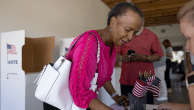
Harris, Trump Voters Differ Over Election Security, Vote Counts and Hacking Concerns
More than seven-in-ten registered voters in the U.S. (73%) think the election this November will be run and administered at least somewhat well. Nine-in-ten Harris supporters say this, compared with 57% of Trump supporters. Just 20% of voters are highly confident the Supreme Court would be politically neutral if it rules on legal issues in the 2024 election.




















